JRDG Company Special – Model 7
1984-1992
Retail Price unknown
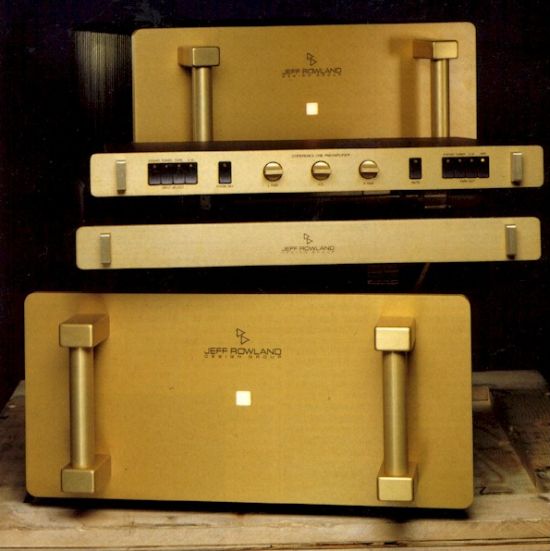
Jeff Rowland started off by making custom designs in the seventies. Later on at the beginning of the eighties he designed a three piece pre-amp and his first Class A, FET input and Zero feedback amp the 2080 (20 Watts stereo, 80 Watts in bridged mode). In 1983 Dr. Roger West of West Laboratories (SoundLab Electrostatics) asked Jeff to develop a powerful and stable amplifier that could drive his newly designed A1 electrostatic speaker.
Jeff designed the WL-500 (WestLabs, 350 Watts) mono amp that could drive the A1 planar and sounded quite good for a high-powered amp. The WL-500 was the inspiring amp for Jeff’s final breakthrough with the Model 7 that had its debut in 1985 driving Dave Wilson’s Audio WAMM System at the CES in Las Vegas.
Rowland’s very first proper commercial poweramplifiers are the model 7 mono blocks shown above together with the Coherence preamp. The 7’s are rumoured to be developed in cooperation with Nelson Pass but this may well be mixed up information. Just the same it is rumoured that the model 7’s were developed because Jeff wanted to be able to drive big Apogee Scintilla magnetostatic speakers (with near zero impedance) without having to resort to non-musical PA amplifiers. With the model 7 he proved that there is indeed such a thing possible as power and finesse at the same time. Interestingly, Krell came into existence for the very same reason. These amps were hugely powerful offering 350 watts in 8 ohms and 700 watts in 4 ohms. Speaker cable connection is via heavy duty screw strip terminals that are compatible with spades and bare wire only. They were not class A but biased pretty highly thus putting out quite a bit of heat. The sound can be described as classic Rowland: sweet, warm and non-fatiguing yet very powerful. Over the years, the Rowland sound has been adjusted to be more agile and expressive.
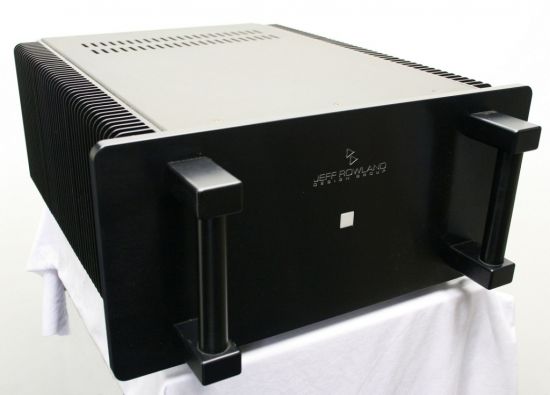
The quality of the Model 7 was acknowledged quickly by the subjective Audio press in the US. Dave Wilson who had a job on the site as a TAS reviewer juxtapositioned it against one of his other favorites the fan-cooled Krell KMA-200 behemoth. This mono-amplifier was introduced by Dan d’Agostino somewhere in 1981 and was probably one of the first high-power Class A amps on the scene. With 200 Watts Class A (idling at almost 600 Watts this design was directly targeted against the Levinson ML-2) per channel it had a huge powersupply with a 2,5 kVA toroid and six 40.000 uF large cans. It used two fans per side to cool down the heatsink tunnels onto which the sixteen power-transistors were mounted. The first production runs had two 800 Watts transformers, probably a legacy from the WL-500, but Jeff quickly responded by incorporating a single 2,5 kVA toroid also which would be resin insulated in a black cubical case in later series. Dave Wilson concluded in this TAS review that these two amplifiers were the curent state of the art regarding solid state amplifier design. Chief editor Harry Pearson, a true Audio Research aficionado, was less enthusiastic but classified these amps as the pinnacle of what was possible with US audio craftmanship.
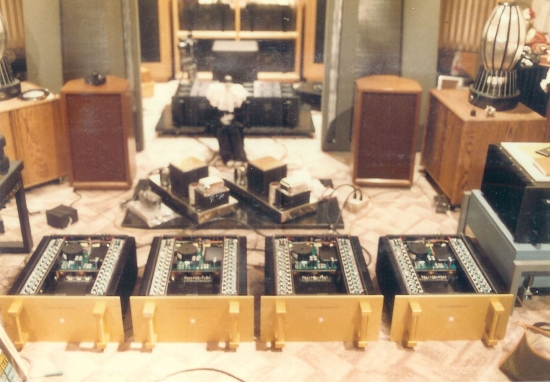
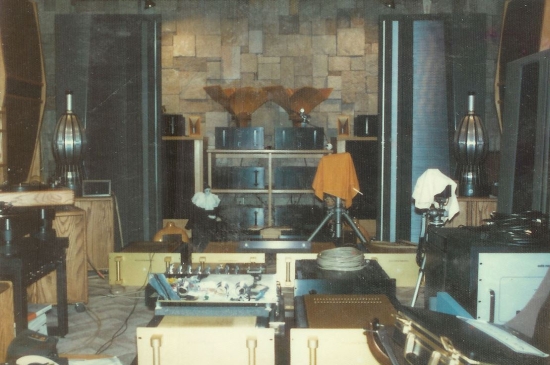
Above two pictures show an application of 4 model 7’s driving the Apogee Full Range magnetostatics via an active crossover
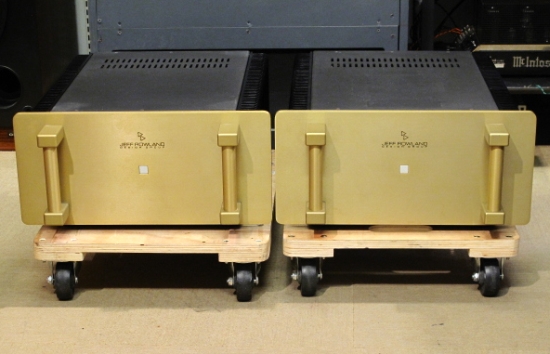
You can tell model 7 and model 5 apart by looking at the handles’ shape: the 7 has square parts while the model 5 (not pictured) has rounded parts.
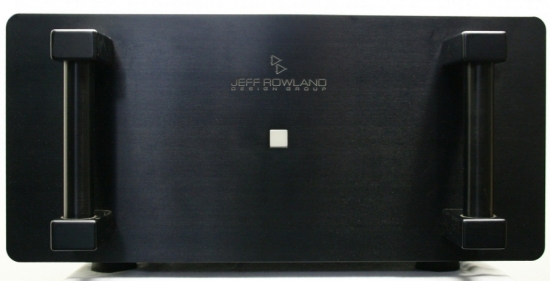
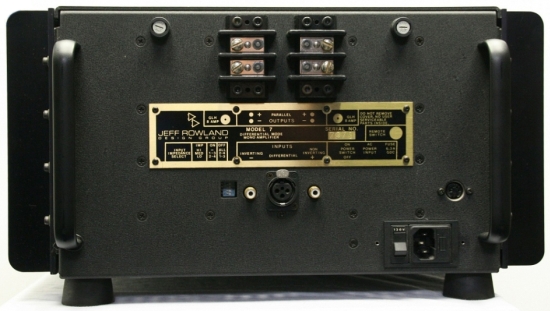

Originally Jeff Rowland amps such as the model 1, model 3 and model 7 used strips with screws for connecting loudspeaker cables. This worked fine for bare wire and spades but would not play ball with bananas. Also, the screws were prone to damage after being tightened and loosened multiple times and would eventually wear out either on the head (making the screwdriver loose grip) or even in the thread. The thing is that the screw sizes used are US standard and these are not easily available in Europe.
More information about JRDG speaker binding posts
Incarnations of the model 7
The different incarnations due to something called R&D followed each other quite quickly without prior notice… After the incorporation of the larger single toroid the frontmodule got its own PCB and later on the actual frontend got encapsulated. The later incarnations used Jeff’s own version of balanced circuitry called Differential Mode. Moreover gain and impedance could be matched with the preamp and the efficiency of the connected speakers. I understand that there are several ( at least 3) different versions of the model 7. Alas it is not clear to me which versions were produced when, and how one can recognise one from another but apparently each version sounded a bit different. According to an article on highendclassics.com the first unbalanced version was less fast and detailed than the next two versions. It had had the typical “warm” Rowland coloration, while the later versions sounded more neutral.
They originally came in three finishes: gold, slate grey and satin black. The slate grey was not an option from the Series three and onwards so most of the last series will be black.
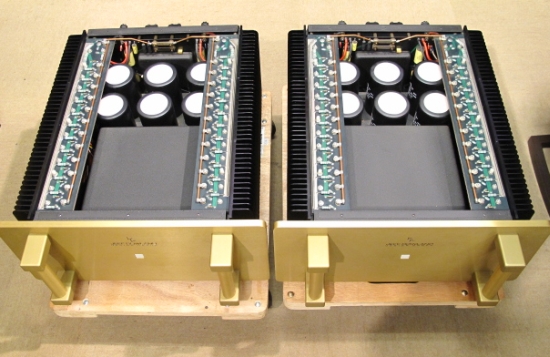
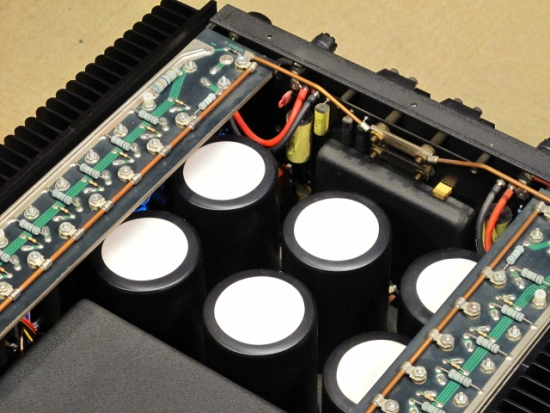
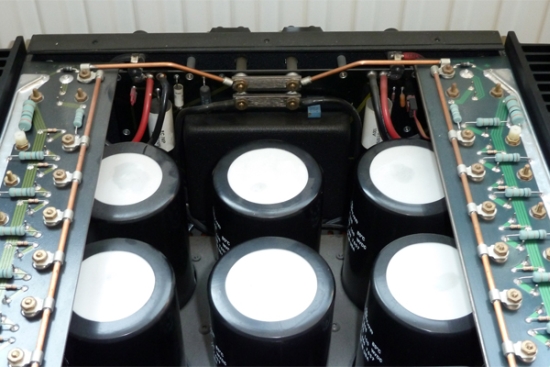
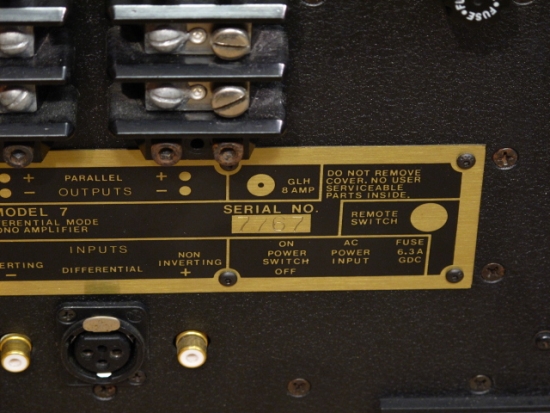
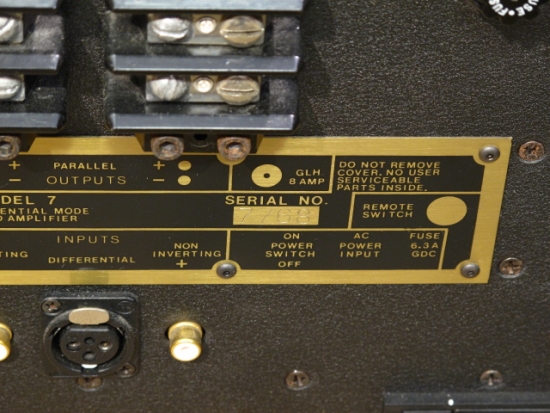
The 3 inside pics above are from a pair with serial numbers 7767 and 7768
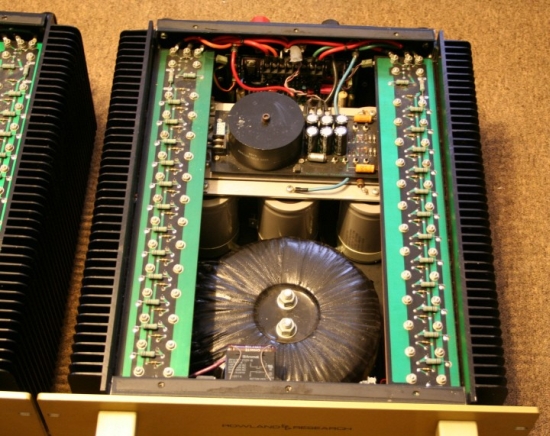
Above is deviating model 7 with normal binding posts, no screening over the power transformer (no resin either) and an extra, smaller power supply.
Model 7 Features
Lack of overall or nested negative feedback eliminates time domain distortion.
Proprietary distortion canceling techniques minimize amplitude related distortions.
Each transistor individually tested and matched for optimum operating
characteristics.
Constant output impedance is maintained over the entire audio range, allowing for
universal compatibility with associated equipment.
The large number of high-speed bipolar output transistors provides uncompromising
reliability and eliminates the need for electronic protection circuitry.
A single voltage amplification stage utilizes field effect transistors (operating in
transconductance mode), which increases low-level signal recognition.
The absence of capacitors, inductors, fuses and protection circuitry throughout the
signal path eliminates the adverse effects of these devices.
A specially designed toroidal power transformer is supported by the substantial
output stage capability.
All critical circuitry is encapsulated in a thermally-conductive epoxy to ensure
excellent thermal stability, mechanical integrity and to facilitate ease of service.
Model 7 Specifications
Output power
350 watts RMS continuous, 8 ohms
700 watts RMS continuous, 4 ohms
1100 watts RMS continuous, 2 ohms
Power Bandwidth
0.15 Hz to 175 kHz, -3 dB
Slew Rate
50 volts per microsecond
THD and Noise
Less than .015%, 1 kHz, 8 ohms, 20 watts
Less than .045%, 1 kHz, 8 ohms, 100 watts
Less than .06%, 1 kHz, 8 ohms, 200 watts
Damping Factor
Greater than 300, 20 Hz to 20 kHz, 8 ohms
Greater than 90, 100 kHz, 8 ohms
Output Current
50 amps peak, continuous
150 amps peak, 0.1 ohm, 20 msec, 1 kHz
Overall Gain
26.4 dB
Sensitivity
136 mV, 1 watt, 8 ohms
Input Impedance
Selectable: 100k, 20k, 600 ohms
Power Requirements
100V-240V
Dimensions
19 in. W x 8.75 in. H x 24 in. D
48 cm W x 22 cm H x 61 cm D
Damping Factor
Greater than 120, 20 Hz to 20 kHz, 8 ohms
Greater than 80, 100 kHz, 8 ohms
The information regarding Jeff’s activities in the seventies and eighties in this article was inspired by an article on highendclassics.com
More Jeff Rowland
Jeff Rowland Company Special Main Page
Jeff Rowland Company Special Power Amplifiers
I had four model 7s driving low end of Duntech Sovereigns as part of a surround sound system. Nothing ever came close before or since. Amazing.
Die Frage DER Fragen ist für mich: WO bekommt man(n) diesen Verstärker im Fall der Fälle fachmännisch und rel. kundenfreundlich geserviced und repariert?
I know a few good repair shops in the Netherlands, but for Germany, I would not know. Perhaps your local distributor can recommend someone?
Guten Tag Herb
Vor ein paar Jahren konnte ich noch originale Driver Units von Jeff Rowland bekommen. Ich habe gehört, dass er diese Verstärker, von welchen ich auch noch 2 Stk. habe, auch heute noch auf den neuesten Stand bringt. Erstaundlich, nicht?
Sonst hab ich einen genialen Elekroniker zur Hand in der Schweiz.
I have them playing here. Big friendly giants it are. They free the sound from the speakers.